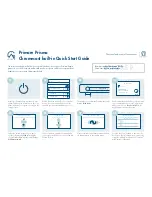
OPERATION AND CONTROLS
8
common with chassis ground by connecting
the "AMP GROUND" and "CHASSIS
GROUND" banana jacks on the rear panel
of the SR560. When connected to AC
power, the chassis of the unit is always
connected to the grounding conductor of the
AC power cord. The inputs are protected to
100 VDC but the DC input should never
exceed 10 Vp. The maximum DC input
before overload is 1 V peak.
The
COUPLING
pushbutton selects the
method of connecting the
A
and
B
inputs to
the amplifier. The inputs can be AC (0.03
Hz - 3 dB) or DC-coupled, or the inputs to
the amplifier can be internally grounded with
the
A
and
B
input BNC’s left floating. This
feature makes for simple offset nulling,
particularly useful when operating the
amplifier DC-coupled at high gains. Please
refer to CALIBRATION AND REPAIR --
OFFSET ADJUSTMENT for information on
the offset nulling procedure.
NOTE: When the coupling is set to AC, a
0.03 Hz cutoff high-pass filter is always
engaged. All high-pass filter modes can still
be selected while AC-coupled, but the 0.03
Hz filter will always be in, even if the filters
are set to DC. Because one of the two filter
sections is always used as a high pass
when AC coupling is selected, low-pass
filters are only available with a 6 dB / octave
rolloff.
The
INVERT
pushbutton allows the user to
invert the output of the instrument with
respect to the input when operating with
single-ended or differential inputs. The
INVERT
LED displays the output sense
relative to the input for all
SOURCE
settings.
Filters
The SR560 contains two identical 1st-order
R-C filters whose cutoff frequencies and
topology (high-pass or low-pass) are
controlled from the front panel. The
maximum bandwidth of the instrument is 1
MHz. The filters in the
FILTER CUTOFFS
section can be configured in the following
six ways:
i. high-pass filter at +12 dB / octave
ii. high-pass filter at +6 dB / octave
iii. high-pass filter at +6 dB / octave,
and low-pass filter at -6 dB /
octave (band-pass)
iv. low-pass filter at -6 dB / octave
v. low-pass filter at -12 dB / octave
vi. no filters in the signal path
The filter settings are controlled by the
ROLLOFF, HIGH-PASS and LOW-PASS
pushbuttons. Each time the ROLLOFF
pushbutton is pressed the instrument
configures the two R-C filters to conform to
the progression shown above. The four
ROLLOFF LED’s give a visual indication of
the current filter configuration. For the
HIGH-PASS filter the left pushbutton serves
to decrease its cutoff frequency. The two
pushbuttons for the LOW-PASS filter
function in an analogous manner.
When the
FILTER CUTOFFS
section is
configured solely as high-pass or low-pass
(i, ii, iv and v ), the cutoff frequency is
illuminated by one of sixteen LED’s in the
range from 0.03 Hz to 1 MHz, and the slope
of the rolloff is shown by one of the four
ROLLOFF LED’s. When the filter section is
configured as band-pass (iii), the cutoff
frequencies are illuminated by two LED’s.
The frequency setting on the left marks the
cutoff for the high-pass filter, and the setting
on the right is the cutoff for the low-pass
filter. The two 6 dB / oct ROLLOFF LED’s
are also illuminated. In this case the two
cutoffs can be set to the same frequency to
provide a narrow bandpass. When both
filters are removed from the signal path (vi)
all rolloff and cutoff frequency LED’s are
extinguished from the FILTER CUTOFFS
section and the DC LED is on.
NOTE: High pass filters are not available
for the four highest frequency settings. See
the note under
Source: Coupling
for
Содержание SR560
Страница 2: ......
Страница 8: ...4...
Страница 10: ...SPECIFICATIONS 6...
Страница 26: ...APPENDIX A A 2...
Страница 30: ...APPENDIX B B 4...
Страница 44: ...SR560 COMPONENT PARTS LIST C 14...













































